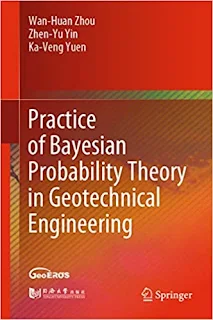Physical Modelling in Geotechnics
Andrew McNamara, Sam Divall, Richard Goodey, Neil Taylor, Sarah Stallebrass and Jignasha Panchal ... 802 pages - Publisher: CRC Press; (October, 2018) - Language: English - ISBN-10: 1138344192 - ISBN-13: 978-1138344198.
Physical Modelling in Geotechnics collects more than 1500 pages of peer-reviewed papers written by researchers from over 30 countries, and presented at the 9th International Conference on Physical Modelling in Geotechnics 2018 (City, University of London, UK 17-20 July 2018). The ICPMG series has grown such that two volumes of proceedings were required to publish all contributions. The books represent a substantial body of work in four years. Physical Modelling in Geotechnics contains 230 papers, including eight keynote and themed lectures representing the state-of-the-art in physical modelling research in aspects as diverse as fundamental modelling including sensors, imaging, modelling techniques and scaling, onshore and offshore foundations, dams and embankments, retaining walls and deep excavations, ground improvement and environmental engineering, tunnels and geohazards including significant contributions in the area of seismic engineering. ISSMGE TC104 have identified areas for special attention including education in physical modelling and the promotion of physical modelling to industry. With this in mind there is a special themed paper on education, focusing on both undergraduate and postgraduate teaching as well as practicing geotechnical engineers.
Physical modelling has entered a new era with the advent of exciting work on real time interfaces between physical and numerical modelling and the growth of facilities and expertise that enable development of so called ‘megafuges’ of 1000gtonne capacity or more; capable of modelling the largest and most complex of geotechnical challenges. Physical Modelling in Geotechnics will be of interest to professionals, engineers and academics interested or involved in geotechnics, geotechnical engineering and related areas.
Physical Modelling in Geotechnics collects more than 1500 pages of peer-reviewed papers written by researchers from over 30 countries, and presented at the 9th International Conference on Physical Modelling in Geotechnics 2018 (City, University of London, UK 17-20 July 2018). The ICPMG series has grown such that two volumes of proceedings were required to publish all contributions. The books represent a substantial body of work in four years. Physical Modelling in Geotechnics contains 230 papers, including eight keynote and themed lectures representing the state-of-the-art in physical modelling research in aspects as diverse as fundamental modelling including sensors, imaging, modelling techniques and scaling, onshore and offshore foundations, dams and embankments, retaining walls and deep excavations, ground improvement and environmental engineering, tunnels and geohazards including significant contributions in the area of seismic engineering. ISSMGE TC104 have identified areas for special attention including education in physical modelling and the promotion of physical modelling to industry. With this in mind there is a special themed paper on education, focusing on both undergraduate and postgraduate teaching as well as practicing geotechnical engineers.
Physical modelling has entered a new era with the advent of exciting work on real time interfaces between physical and numerical modelling and the growth of facilities and expertise that enable development of so called ‘megafuges’ of 1000gtonne capacity or more; capable of modelling the largest and most complex of geotechnical challenges. Physical Modelling in Geotechnics will be of interest to professionals, engineers and academics interested or involved in geotechnics, geotechnical engineering and related areas.



















